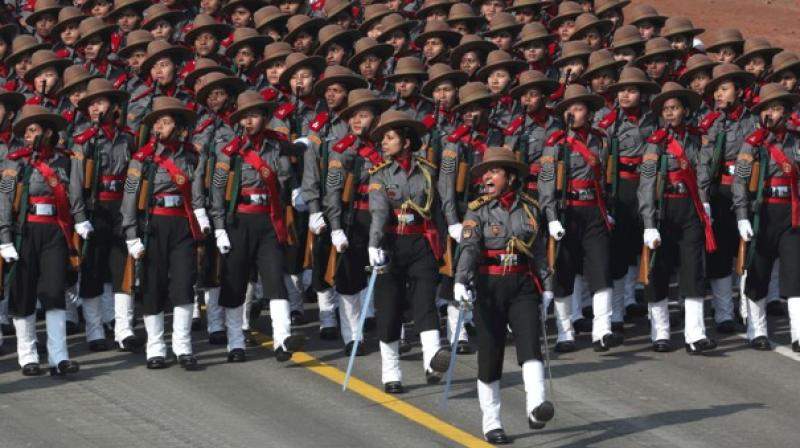
SC decision on women officers an instrument of social change
The Supreme Court's decision to entitle women Army officers to be elevated to command positions will change the culture of patriarchy that characterises the Indian armed forces.

The Supreme Court’s decision to entitle women Army officers to be elevated to command positions will change the culture of patriarchy that characterises the Indian armed forces.
The Army leadership attempts to make men out of boys, but is unable to make men out of girls which poses problems for the organisational structure. All along the military infrastructure and ethos has been geared towards men and the entry of women has yet to alter the organisational dynamics in terms of postings, awards and accommodation.
Over 28 years of women in the Army, their male counterparts, especially the senior leadership have tended to pamper and protect them due to the novelty factor. The resistance to women in the Army often arises because the leadership discriminates between male and female officers in the allotment of routine duties or awards. Such attitudes and practices sometimes result in an extra burden on male officers.
Perhaps the thinking that command positions require complete dedication to organisational interests at the cost of family commitments may have conditioned the institutional mindset that women given their maternal instincts and responsibilities could prove unsuitable to discharge such duties. In turn, such impressions about women and their role in society arise from cultural conditioning which over the years has resulted in discrimination against them. Men and women are physically and mentally not similar. Women demonstrate their physical prowess in athletics and sports, but men and women do not compete against each other which only highlights their physical differences.
Related news | Women in Army can be commanding officers now: All you need to know
The rural, feudal argument
The argument that the rank and file of soldiers, sailors and airmen are predominantly recruited from rural areas with a feudal culture synonymous with patriarchy and would therefore find it difficult to accept women as their officers, becomes irrelevant today. For instance, in villages only men would drive tractors and not women whose social role was confined to the home, family and child care. While these social conditions were relevant till two decades ago, the social environment has transformed with women entering male bastions to become drivers of commercial vehicles, metro train drivers, police constables and bus conductors at the lower end of the socio-economic strata. Also an increase in female literacy has helped to change perceptions of women’s role in society.
Till now women were treated as second class citizens in the Indian Army and could only serve for a few years or short service commissions and shed their uniforms thereafter. There was absolutely no question of command positions or permanent commissions for women officers. But after a case that has dragged on in the Supreme Court since 2010 over the matter, women are finally on a par with men in the Army in terms of career prospects. To that extent the Indian Army discriminated against women officers on the grounds of gender which goes against constitutional principles.
Women entered the Indian Army as officers since 1992 and the armed forces have had their set of challenges to accommodate them over the years. Before this judgment, the Indian Air Force (IAF) has allowed women to fly as fighter pilots. Except for women as fighter pilots, the Army and Navy have women officers only in combat support roles like logistics, and education; while the Army has women officers in the intelligence, ordnance, signals, Army aviation, education, electronics and mechanical engineers, besides corps of engineers.
West and East gap
At one level South Asia is not culturally like the western industrial democracies where the free intermingling of men and women lacks taboos. Yet, India has had women break the glass ceiling in almost every sphere except the Army. At the same time, it would be relevant to mention women warriors like Rani Laxmi Bai of Jhansi who valiantly fought British colonial rulers and Rani Abbaka Chowta from coastal Karnataka who defeated Portugese colonisers in 1500s, gave a glorious account of themselves as combat leaders in history.
Lately, the Indian Army has recruited women as personnel below officer rank into the Corps of Military Police for the first time. Otherwise, the Army only had women in its officer corps and not as soldiers and in fact neither do the Indian Navy nor the Air Force have women recruited as personnel below officer rank. For instance, women officers in the Indian Navy do not serve onboard warships due to constraints of space which does not allow for separate toilets or cabins. The only exception to women in the military has to with fighter pilots in the air force who could get shot down, captured and become prisoners of war. While the Geneva Conventions may theoretically be applicable to protect them – in reality the enemy could abuse women prisoners which poses its own problems.
Related news | Women officers for command roles in Army: SC says ‘forward march’
Women officers in the military need to earn the respect of their soldiers, sailors and airmen like their male counterparts have to do. While the role of women has transformed over the years across the country in both rural and urban India the military too needs to acknowledge this change and facilitate them to rise in the military hierarchy.
In a sense with the Supreme Court decision to enable women officers to hold command positions the Army becomes an instrument of social change in the country.
(The writer is a Professor of International Relations and Strategic Studies at the Christ Deemed to be University, Bengaluru)


